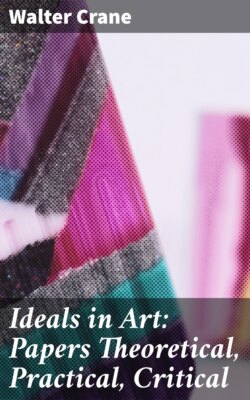Читать книгу Ideals in Art: Papers Theoretical, Practical, Critical - Walter Crane - Страница 3
На сайте Литреса книга снята с продажи.
PREFACE
ОглавлениеTable of Contents
The collected papers which form this book have been written at different times, and in the intervals of other work. Most of them were specially addressed to, and read before the Art Workers’ Guild, as contributions to the discussion of the various subjects they deal with; so that they may be described as the papers of a worker in design addressed mainly to art workers. They are not, however, wholly or narrowly technical, and the point of view frequently bears upon the general relation of art to life.
Some of the papers were delivered as lectures to larger audiences, and others have appeared as articles, mostly in journals devoted to art.
Of the former, the one upon the Arts and Crafts movement was prepared for and read as one of a series of lectures given during a recent exhibition of the Arts and Crafts Exhibition Society, and is now for the first time printed in its entirety.
The “Thoughts on House-Decoration” was read before the convention of the National Association of Master Painters and Decorators recently held at Leicester.
“The Influence of Modern Social and Economic Conditions on the Sense of Beauty” was the substance of an address at the opening of a debate on that question at a meeting of the Pioneer Club.
The paper on “The Progress of Taste in Dress” was written for “The Healthy and Artistic Dress Union,” and appeared in their journal “Aglaia.” The article on Mr. Chesterton’s book appeared in “The Speaker”; that on “The Teaching of Art” in “The Art Journal.”
The notes on “Gesso” work appeared in an early number of “The Studio,” and I have to thank the editor, Mr. Charles Holme, for kindly allowing me to reprint it here, and also for the loan of the blocks used for the illustrations, both for this and others of the papers.
My best thanks are also due to Mr. Ernest Gimson for the loan of photographs of his cottage at Stoneywell; to the Earl of Pembroke for enabling me to obtain those of the double cube room at Wilton; to Mr. Charles Rowley, and Mr. Charles W. Gamble of the Municipal School of Technology, Manchester, for photographs of the Madox Brown frescoes; to Mr. Augustus Spenser and Mr. FitzRoy, the Principal and the Registrar of the Royal College of Art, for their help in obtaining for me the examples of the work of the students given; and to Mr. Arthur P. Monger for the care he took in photographing them; also to Mr. Kruger of the Royal College, for the use of his admirable drawing of the decorations of Westminster Bridge, which appeared in “The Magazine of Art,” and is now reproduced by permission of Mr. M.H. Spielmann and Messrs. Cassell.
I should like to add a note or two on some of the illustrations, on other points not commented upon in the papers.
The sketch plan and elevation of a collective dwelling (at page 116), for which I am indebted to my architect-son, is offered as a suggestion of what could be done in this way on very simple lines. Each tenant in such a collective dwelling would have his private house or cottage, with the advantage of the use of the common dining-hall, and the service of a collective kitchen; also a general reading-room, and to these rooms a vaulted way with an open arcade on the side next the quadrangle would enable each tenant to reach this part of the building under cover from his own dwelling, which comprises a private garden, as well as the use of the common quadrangle.
From the architectural point of view grouped dwellings, upon some such principle as here suggested, would undoubtedly lend themselves to artistic and pleasant treatment, and would mitigate the depressing effect of the monotonous rows of squat dwellings intended for our workers’ homes, and the mean sameness of the streets, which are spreading around our great towns in every direction, only, it is to be feared, to form slums in the future.
In regard to Manchester, spoken of on page 119, another practical step has been taken in the much-needed direction of school-decoration. Through the public spirit of Mr. Grant, one of her citizens, who has found money enough to start the work, students of the Municipal School of Art are enabled to carry out on a large scale mural paintings upon the upper walls of the class-rooms in one of the principal primary schools. The subjects have been enlarged from some of my coloured book designs such as “Flora’s Feast.” Such work might not only be made to bear most helpfully on the general work of education, but in itself be an important side of school influence, since by means of large simple typical mural designs great historical events and personages, as well as natural form, might be made familiar to the eyes of children at the same time that their sense of beauty and imaginative faculties were appealed to.
Local history might in this way be preserved also. In this connection one was glad to see the other day at Hoxne (the ancient Eagles-dune) in Suffolk the school-house connected with the history of the place by having a figure of St. Edmund carved as a finial of the chief gable, with a relief in stone let into the wall beneath, illustrating the incident of the saintly king being taken by the Danes at the bridge, while an inscription mentions that the building marks the spot, and the date of his death in 870.
WALTER CRANE.
YEW TREE FARM,
September, 1905.
